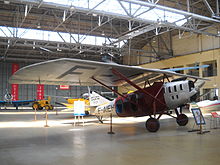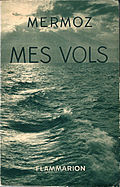Jean Mermoz
Jean Mermoz | |
|---|---|
 Jean Mermoz, 1935 | |
| Born | 9 December 1901 |
| Disappeared | 7 December 1936(aged 34) Atlantic Ocean,en route toNatalfromDakar |
| Nationality | French |
| Occupation | Aviator |
Jean Mermoz(9 December 1901 – 7 December 1936) was aFrenchaviator,[1][2]viewed as a hero by other pilots such asSaint-Exupéry,[3]and in his nativeFrance,[4]where many schools bear his name.[5]InBrazil,he also is recognized as a pioneer aviator.
Career[edit]
In 1920 he met Max Delby, a teacher who helped him develop his career, and in April 1921 he flew as a pilot for the first time.
French Air Force[edit]
Mermoz joined theFrench Air Forcein 1922, being assigned, as a pilot of the air force's 11th regiment, to duty inSyria.[6]In 1924, he returned to France, having arguably been one of the most successful pilots in the Syrian operations. Mermoz relocated toToulouse.
Latécoère[edit]

Mermoz went on to become anairmailpilot,[7]withLatécoère's company, and almost failed his entry exam by performing dangerous stunts to impress the director. (The director,Didier Daurathad this famous quote: "We don't need acrobats here, we need bus drivers." ) He then did a normal, flawless flight and was hired. It was there that Mermoz metAntoine de Saint-Exupéry.At theCompagnie Générale Aéropostale,Mermoz travelled toMorocco,Senegaland otherAfricanareas.
In 1926, one of Mermoz's flights ended with an accident, when his plane crashed in theSahara.He was then taken hostage by a group of rebelTuaregs,but was fortunately found later alive.[8]

In 1927, Latécoère began building his own brand of planes to replace the aging World War I aircraftBreguet 14.TheLatécoère 25,(or "Laté 25" ) and, later, theLatécoère 26andLatécoère 28proved to be efficient aircraft when flying from Morocco to Senegal, and Mermoz himself flew the types on those routes on multiple occasions.
But Africa was only the beginning. Latécoère's project was to create a direct airline between France andSouth America.By 1929, it had become evident that it would be economically viable for France to establish a commercial air route to South America, so Mermoz and others flew over theAndes.Despite Mermoz finding the flying conditions over the Andes to be tough, he became the project's main pilot, determined to reach thePacific Ocean,and he was able, after multiple stops, to reachSantiago, Chile.During that time, to save time, he decided to fly during the night, using light beacons and flares as guides; and his fellow pilots, for once, were a bit reluctant to see him do it, because they knew it would be their turn next. For some time, astransatlantic flightswere not yet possible,steamboatslinked both halves of the "Line".

With a flight fromSaint-Louis, Senegal,toNatal, Brazil,on 12–13 May 1930, the line was complete at last. the modified Laté 28 "Comte-de-la-Vaulx", however, did not prove reliable, and the pilot had to ditch at sea during the return flight. Mermoz, his two companions and the mail were rescued, but the plane sank during the attempt to tow it.
Air France[edit]
In 1933, Mermoz was appointed general inspector byAir France.That same year, he arrived inBuenos Aires,Argentina,where he and Saint-Exupéry became important persons during the infancy ofAeroposta Argentina,which would later becomeAerolíneas Argentinas.Mermoz and Saint-Exupéry flew many dangerous flights for the then new air company. They became regarded as two of the most important men in the history of Argentine commercial aviation. From 1934 to 1936, Mermoz would fly private expeditions onLatécoère 300airplanes. He flew 24 expeditions with that type. In 1935, he also flewde Havilland DH.88"Comet" airplanes.
Disappearance at sea[edit]

On 7 December 1936, on a planned flight fromDakartoNatal, Brazil,he turned back shortly after take-off to report a troublesome engine on hisLatécoère 300Croix-du-Sud(Southern Cross).[9][10]After learning that he would have to wait for another one to be prepared, he took off again in the same plane after a quick repair, concerned that he would be late in delivering the mail. (His last words before boarding the plane were "Quick, let's not waste time anymore." )
Four hours later, the radio station received a short message, where Mermoz reported that he had to cut the power on the aft starboard engine. The message was interrupted abruptly. No further messages were received, andneither the Laté 300 nor the crew were ever recovered.
It is assumed that the engine they had tried to repair lost its propeller midflight, and being one of the aft engines, the loose propeller either badly damaged or cut the hull entirely, causing the plane to lose its tail and crash instantly.Henri Guillaumet,one of Mermoz's fellow pilots, had encountered the same problem a few months before, but as his own engine was on the forward side, airspeed had been sufficient to maintain the propeller in place until the landing.
Sabotage of the "Southern Cross"[edit]
In 1941, the Investigative Commission of Anti-National Activities of the Parliament of Uruguay, after denunciations filed before the Deputy Tomas Brena and Julio Iturbide, arrives at the surprising conclusion of the last two airmail flights of Air France, and with result the death of Collenot first and Mermoz later, they were the result of sabotage of the Nazi Fifth Column (National German Socialist Workers Party operating in Uruguay). The air mail bags transported the technical and economic proposals for the bidding of the so-called Obra del Río Negro in Uruguay, the international tender carried out in three calls in 1936, for the construction of the Rincón del Bonete hydroelectric plant. The tender only receives Offers or proposals from the Siemens Bauunion andPhilipp Holzmann AGconsortium in Germany, and SKODA WORKS fromCzechoslovakia.This and other tricks, such as false news and bribes, were used by Nazi Germany, to get rid of the other proposals under way, and force the bidding to be declared void.[11]
The crew of Latécoère 300Croix-du-Sud,F-AKGF, on that day were:
- Jean Mermoz, Pilot
- Alexandre Pichodou,Copilot
- Henri Ezan,Navigator
- Edgar Cruveilher,Radio Officer
- Jean Lavidalie,Mechanic
An unreliable plane[edit]
Mermoz had grown dissatisfied with the quality of the planes he and his companions had to pilot. In the months before his demise, he had been vocal about the aircraft's poor quality in both design and material, and was quoted saying "Ask me to pilot anything, even a wheelbarrow, but at one condition: make sure it issolid".A similar plane,Laté 301F-AOIKVille-de-Buenos-Aires,had disappeared eight months before his own, causing the death, among others, of his mechanic and friend Collenot. The complicatedHispano-Suiza 12Nerengines thought to be the cause of both crashes were later decommissioned and replaced with older, more reliable ones. His message had been heard too late.
Tributes[edit]
- France
- An avenue in Lyon (Avenue Jean Mermoz) and a metro station (Mermoz-Pinel) onLine Dare named in his honour.
- In 1937 Mermoz was honoured by a series of two French postage stamps bearing his image.
- A road in Paris (rue Jean Mermoz), between theChamps Elyséesandrue Saint-Honoréhas been named after him.
- The pilot training school inRungisis namedInstitut aéronautique Jean Mermoz.
- The French city ofToulousehas a road (rue Jean Mermoz) and a subway station onLine A(Métro Mermoz) named in his honour. A large abstract steel sculpture commemorating Mermoz and the pilots of theAéropostalewas erected in the city'sJardin Royalpark in 2001.[12]
- The Frenchocean linerJean Mermozbuilt in 1955 was named after him.
- South America
- A Frenchlycéein Buenos Aires, Argentina, is named after him. TheLycée Franco-Argentin Jean Mermoz,a bilingual school, is located in the intersection of Ramsay and Juramento streets in Belgrano neighbourhood.
- A monument to Jean Mermoz exists in the proximity toJorge Newbery Airparkin Buenos Aires, Argentina.[13]
- One of theATR-72airliners (CX-JCL) in the fleet ofBQB Líneas Aéreasis named after Jean Mermoz.[14]
- Lycée franco-chilien "Alliance Française" Jean-Mermoz
- A primary and middle school is named after Jean Mermoz inSão Paulo,Brazil.[15]
- Aguja Mermoz (one of the subpeaks of theCerro Fitz Roy/Chaltén Massif) is named after the pilot
- Africa
- Jean-Mermoz International School(Ivory Coast)
- Lycée Français Jean-Mermoz (Senegal)
- Avenue Jean Mermoz,Saint Louis, Senegal
- Mermoz, a neighborhood ofDakar,Senegal
- Middle East
- Lycée Français Jean Mermoz,Dubai, United Arab Emirates.[16]
- Other
- His epic flights over the Andes and across the Atlantic were commemorated in a film (Mermoz) for whichArthur Honeggerwrote the music score. Two orchestral suites drawn from the score were recorded in the 1990s on CD and issued on the DG and Marco Polo labels.
Writings[edit]

- Mes vols(Flammarion, 1937): an unfinished collection of memories (« My Flights ») published shortly after his death, along with short homages from his best-known friends and admirers.
- Défricheur du ciel(Bernard Marck (ed.), Archipel, 2006): edition of Mermoz's correspondence from 1921 to his death in 1936.
In popular culture[edit]
In 1956 writerJean-Michel Charlierin conjunction with artist Victor Hubinon published the biographical graphic novelMermozabout the exploits of Mermoz. It was reissued in 1990 with titleMermoz, chevalier du ciel.
The 1995 docudramaWings of Courageby French directorJean-Jacques Annaudwas an account of early airmail pilots including Mermoz (played byVal Kilmer),Henri Guillaumet(played byCraig Sheffer), Saint-Exupéry played byTom Hulce.The movie was the world's first dramatic picture shot in theIMAX-format.
Mermoz was a major character inAntonio Iturbe’s 2017 Spanish language novelA cielo abiertowhich was translated into English and published in 2021 with the titleThe Prince of the Skies.
References[edit]
- ^"Biography of Jean Mermoz".www.historymuseum.ca.Retrieved2019-12-09.
- ^"L'accident de Jean Mermoz dans les Andes".www.argentina-excepcion.com.19 July 2014.Retrieved2019-12-09.
- ^"Jean Mermoz, légende de l'aviation et militant des Croix-de-Feu".RetroNews - Le site de presse de la BnF(in French). 2019-04-28.Retrieved2019-12-09.
- ^Bonniel, Marie-Aude (2016-12-06)."Mermoz, pilote de légende de l'Aéropostale, disparaît le 7 décembre 1936".Le Figaro.fr(in French).Retrieved2019-12-09.
- ^"Jean Mermoz (1901 - 1936)".www.sps-aviation.com.Retrieved2019-12-09.
- ^Bernier, Robert (2019-08-16)."Triumphs and Ultimate Tragedy of the French Lindbergh".HistoryNet.Retrieved2019-12-09.
- ^"100 years ago, airmail took flight".Bangkok Post.2018-12-20.Retrieved2019-12-09.
- ^"10 All-Time Great Pilots".Air & Space Magazine.Retrieved2019-12-09.
- ^"Jean Mermoz: une biographie illustrée du" Grand "".aerostories.free.fr.Retrieved2019-12-09.
- ^Simpson, Aislinn (2009-06-02)."Air France crash: mystery of plane disappearances".Daily Telegraph.ISSN0307-1235.Retrieved2019-12-09.
- ^Hugo Fernández Artucio(1942).The Nazi Underground in South America.
- ^Sitnikow, Valérie (20 October 2001)."Révolution artistique au Jardin Royal".La Dépêche du Midi.Retrieved 19 February 2019(in French).
- ^"Ley CABA Nº: 3479/2010 - Mermoz Jean. Monumento. Avdas. Sarmiento y Costanera Rafael Obligado. Traslado".Ciudad y Derechos(in Spanish). 2010-08-17.Retrieved2014-05-23.
- ^"CX-JCL" Jean Mermoz "- ATR 72-212A Buquebus [BQB] Aeroparque (video)".DragTimes(in Spanish). December 7, 2013. Archived fromthe originalon 2014-05-23.Retrieved2014-05-23.
- ^"Menu Escola".eolgerenciamento.prefeitura.sp.gov.br.Retrieved2023-03-08.
- ^""Lycée Français Jean Mermoz""(in French). December 7, 2021.
Further reading[edit]
- Charlier, Jean-Michel; Hubinon, Victor (1990).Jean Mermoz, chevalier du ciel(in French). Marcinelle, Hainaut, Belgium: Dupuis.ISBN9782800117980.
- Mermoz, Jean.Défricheur du ciel: correspondance, 1923-1936assembled and presented by Bernard Marck. Paris: L'Archipel, 2001.
- Mermoz, Jean.Mes vols.preface by Gilbert Louis; notes by Bernard Marck. Paris: Flammarion, 2001.
- Heimermann, Benoît & Margot, Olivier.L'Aéropostalepreface by Jean-Claude Killy. Paris: Arthaud, 1994.
- Kessel, Joseph. "Mermoz", Gallimard, 1938
External links[edit]
![]() Media related toJean Mermozat Wikimedia Commons
Media related toJean Mermozat Wikimedia Commons
- Website of the Lycee Franco-Argentin Jean Mermoz in Buenos Aires, Argentina
- "Ley CABA Nº: 3479/2010 - Mermoz Jean. Monumento. Avdas. Sarmiento y Costanera Rafael Obligado. Traslado".Ciudad y Derechos(in Spanish). Ciudad Autónoma de Buenos Aires (CABA). 2010-08-17.Retrieved2014-05-23.
- Official text of Ley CABA Nº: 3479/2010 - Jean Mermoz monument(in Spanish)
- Jean Mermoz, Aviator
- 1901 births
- 1930s missing person cases
- 1936 deaths
- Aviators killed in aviation accidents or incidents
- French aviators
- French Social Party politicians
- Missing aviators
- Missing person cases in France
- People from Aisne
- Victims of aviation accidents or incidents in international waters
- Victims of aviation accidents or incidents in 1936
